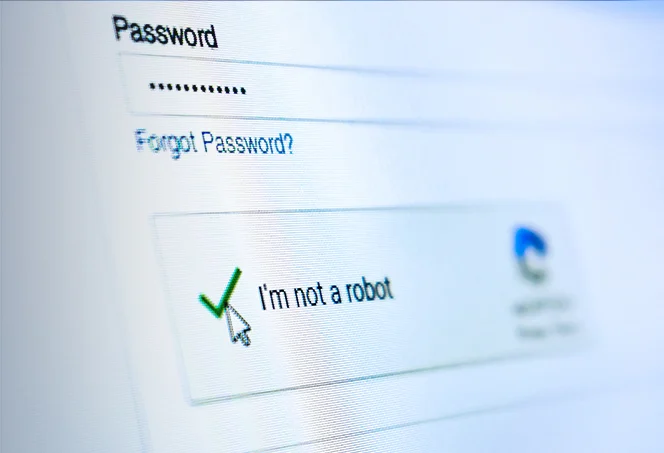Have you ever tried to sign in to a website or make an online purchase, only to be faced with a challenge to identify specific images, solve a puzzle, or complete a task to prove you’re a human? This is a CAPTCHA (Completely Automated Public Turing test to tell Computers and Humans Apart), and is used worldwide by websites to detect and prevent bot activity.
However, there are advanced web scraping tools that can dodge such anti-bot mechanisms.
For instance, ZenRows is a powerful web scraper software with various functionalities such as the ability to bypass Turnstile CAPTCHAs (Cloudflare’s smart alternative to Google’s reCAPTCHA) along with multiple other CAPTCHA systems.
Whether you’re a business owner looking to prevent your website from getting scraped or wish to scrape other web pages to gather data, this article can help you learn more about CAPTCHAs and anti-bots and how they work.
What is an anti-bot?
An anti-bot is a security mechanism or technology that websites and online services use to detect and block harmful bots. It simultaneously allows legitimate human users and good bots (like search engine crawlers) to access their platforms seamlessly.
How does an anti-bot work?
Anti-bot mechanisms use the latest technologies, including Machine Learning and Artificial Intelligence to monitor and analyze web traffic for potential bot activity. They employ various techniques such as:
- User behavior analysis: Studying user interactions, mouse movements, and typing patterns to identify bot-like behavior
- Device fingerprinting: Collecting and analyzing attributes like device type, browser, operating system, and network settings to create a unique digital fingerprint for each user
- CAPTCHAs (also known as Turing tests): Presenting challenges, such as image recognition, audio transcription, or simple puzzles that are easy for humans to solve but difficult for bots
Additionally, it’s crucial to keep in mind that bot algorithms are advancing and becoming more sophisticated, leveraging AI to bypass anti-bot technologies. Therefore, anti-bot systems must constantly evolve to keep up with these algorithms.
What is a CAPTCHA and what is it used for?
A CAPTCHA is a technology that determines whether an online user is a human or a bot. CAPTCHAs are commonly used for various purposes, including:
- Preventing Ticket Scalping: Stopping bots from bulk-purchasing event tickets for resale at inflated prices.
- Account Creation: Ensuring that only humans can create accounts, blocking bots from creating fraudulent accounts.
- Reducing Fraud Payments: Preventing bots from using stolen payment information for online transactions.
- Protecting Online Comments: Ensuring that only humans can post comments online, restricting bots from posting spam or unsafe content.
- Maintaining Accurate Survey Results: Prohibiting bots from participating in online polls and surveys, preserving data integrity.
How do CAPTCHAs work?
CAPTCHAs present a puzzle or test that is straightforward for humans yet challenging for bots to solve. Upon submission, an advanced algorithm verifies whether the user’s response is human-generated, blocking bot access if detected.
Eight types of CAPTCHAs used by anti-bots
#1 Text
Shows a series of distorted letters and numbers that the user must enter into a text box to gain access.
#2 Image
- Displays an image containing an object or shape, and the user must identify what it is.
- Can also require a user to select specific images from a grid, rotate images until aligned correctly, and perform other image-related tasks.
Image-based CAPTCHAs are known to be more difficult for bots to solve than text-based CAPTCHAs since they require semantic classification and image recognition.
#3 Audio
- Presents an audio file containing a sequence of letters and numbers that the user must transcribe into a text field.
- Example: Listen to the audio and type what you hear.
#4 Math or word problems
- Requires users to solve a simple math problem (e.g., basic addition or subtraction), complete a sequence of related terms, or enter the missing word in a sentence or phrase
- Example: 5 + 3 = ?
#5 Social media sign-in
Users are required to sign in using one of their social profiles (e.g., Google, Facebook, or LinkedIn) to access the website or service.
Upon doing this, a user’s details will get automatically populated by the platform’s Single Sign-On functionality – an easier mechanism than other types of CAPTCHAs.
#6 reCAPTCHA
Google’s reCAPTCHA is considered more secure and user-friendly than traditional CAPTCHAs.
Users are initially presented with a checkbox that says “I’m not a robot,” and they gain access immediately if their behavior is deemed human-like.
reCAPTCHA uses mechanisms such as IP tracking and user behavior analysis to understand if the activity is done by a human or a bot.
If the system detects potential bot activity, the user may be prompted to undergo an additional image-based CAPTCHA test for verification.
Example:
#7 Behavioral CAPTCHAs
A behavioral CAPTCHA is one of the newer CAPTCHA methods introduced to boost security measures.
It examines a user’s typing speed and mouse or trackpad movements to differentiate humans and bots.
Analysis of these interactions over time can result in more efficient bot identification.
#8 3D CAPTCHAs
A 3D CAPTCHA is another new method introduced for strengthened protection from bots.
These types of CAPTCHAs were created based on the assumption that humans can identify 3D characters better than bot algorithms. It’s a more complex variation of the text-based CAPTCHA.
Benefits of anti-bot technology
- Anti-bot technology operates at the highest level of accuracy. No humans or safe bots (such as web crawlers or spiders used by search engines to index and rank web pages) are blocked by anti-bots.
- Humans and good bots can access a website or service and operate uninterrupted while malicious bots are blocked immediately.
- Anti-bot mechanisms ensure that harmful bots don’t steal sensitive information such as passwords and credit card information.
- Some anti-bot solutions can also provide insights into bot attacks as they take place. However, it can be quite tedious to gather these insights.
Five alternatives to CAPTCHAs
While CAPTCHAs are widely used, they can sometimes be challenging or frustrating for legitimate users. In certain situations, websites may opt for alternative bot detection and prevention methods such as:
#1 Honeypots
Hidden form fields or links that are invisible to humans but can be accessed by bots, allowing websites to detect and block bot traffic. Unfortunately, advanced and sophisticated bots can potentially identify and avoid these virtual traps.
#2 Two-factor authentication (2FA)
Requiring users to provide an additional verification method (e.g., a one-time code sent to their phone or email) in addition to their password, making it more difficult for bots to gain access.
#3 Rate limiting
Monitoring and limiting the number of requests or actions a user can perform within a specific time frame, preventing bots from overwhelming the system with excessive traffic.
This mechanism prevents malicious bot activity by tracking the number of requests coming from different IP addresses and how often these requests take place.
If there are too many requests coming from a single IP address within a certain timeframe, the rate limiting mechanism will block the IP’s requests for a fixed amount of time.
#4 Email verification
Sending verification codes or links to users’ email addresses to confirm their identities before granting access.
#5 Device fingerprinting
Device fingerprinting helps to identify instances of possible unauthorized access and detect fraudulent activities.
It is a security technique that collects various attributes of a user’s device such as the device type, software details (browser type and operating system version), behavioral patterns (typing speed, trackpad or mouse movements), and network data (network settings and IP address) to create a unique digital fingerprint.
These digital fingerprints can help confirm if a user is accessing their account from a recognized device or if a potential breach in security has taken place.
It’s important to note that these alternatives may not be as effective as CAPTCHAs in certain scenarios and should be carefully evaluated and implemented based on the specific needs and requirements of the website or service.
To summarize
In this comprehensive article, we’ve explored the various types of CAPTCHAs and anti-bot technologies, covering their definitions, purposes, types, benefits, and alternatives. As cyber threats continue to evolve, it’s crucial for businesses and website owners to stay informed and educated on these essential security measures.
Additionally, understanding how to bypass these mechanisms responsibly, with the help of advanced web scraping tools like ZenRows, can provide valuable insights and data for research and strategic purposes.
Staying vigilant and adopting a multi-layered approach to bot detection and prevention is key to maintaining a secure and trustworthy online environment for all.











